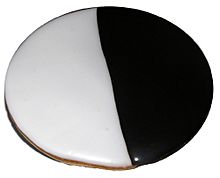Black and white cookie facts for kids
 |
|
| Alternative names | Half-and-half cookie |
|---|---|
| Type | Cookie |
| Course | Dessert |
A black-and-white cookie, half-and-half cookie, or half-moon cookie is a round cookie iced or frosted on one half with vanilla and on the other with chocolate. In the German language they are called Amerikaner. There are regional differences: a black-and-white cookie is flat, has fondant icing on a denser cake base, and is common in New York City, while a half-moon cookie is slightly dome-shaped, has frosting on a fluffier cake base, and is common in Central New York and Boston. Often one side is frosted higher than the other. Black-and-white cookies may also be found with frosting instead of fondant.
The origin of the black-and-white cookie in New York City is commonly traced to Glaser's Bake Shop, founded in 1902 by Bavarian immigrants in the Yorkville neighborhood of Manhattan. The black-and-white cookie was among the original recipes used by the bakery. Half-moon cookies, however, can be traced to Hemstrought's Bakery in Utica, New York, around 1925. The relationship between the two origins is murky; it is likely that both recipes share a common German root, although the origin and name of Amerikaner in Germany is also unclear. Purported explanations include a corruption of the word Ammoniumhydrogencarbonat (ammonium bicarbonate, a leavening agent), or that the cookie was (re)introduced to Germany by American GIs in the 1950s. German Amerikaner are often frosted entirely in white frosting. In the former East Germany, due to anti-American sentiment, the name Ammonplätzchen (Ammonia cookies) was used.
Images for kids
-
Half-moon cookies and black-and-white cookies in a grocery store in New Hartford, New York (near Utica). The half-moon cookies are significantly larger.
See also
 In Spanish: Black and white cookie para niños
In Spanish: Black and white cookie para niños



